The Bloody Eighties
In which Norm revisits some '80s horror favorites ... and not-so-favorites. 'Tis the season.
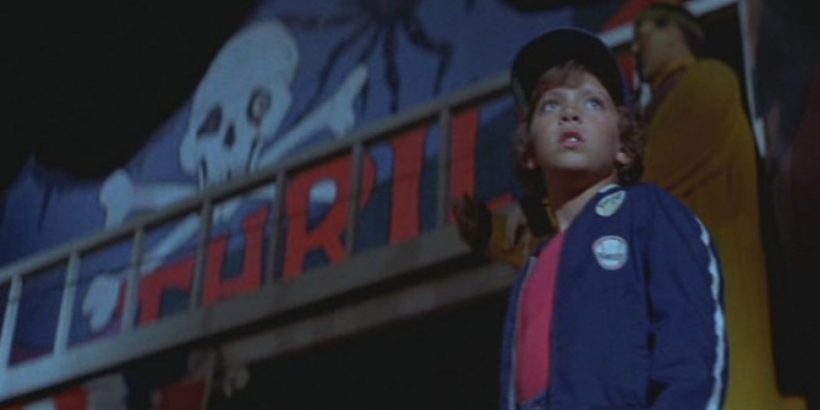
Well, it’s officially fall now, and the pumpkin spice season brings a whole new wave of horror movies arriving just in time for Halloween. It’s a fun excuse for me to spend way too much time revisiting old favorites – and not-so-favorites – and this week, a glut of movies turned up to remind me just how messy the genre was when I was a kid.
I mean, have you seen Friday the 13th recently? It’s godawful! Sure, it codified the slasher movie after Bob Clark’s Black Christmas and John Carpenter’s Halloween established the framework, but Sean S. Cunningham’s 1980 tale of summer-camp counsellors being picked off one by one by a mysterious killer is also a truly bad movie, as I discovered while rewatching Paramount’s new 4K release. The disc includes both the original theatrical version and the unrated cut, and both look better than they ever have, but I’m not sure that helps.
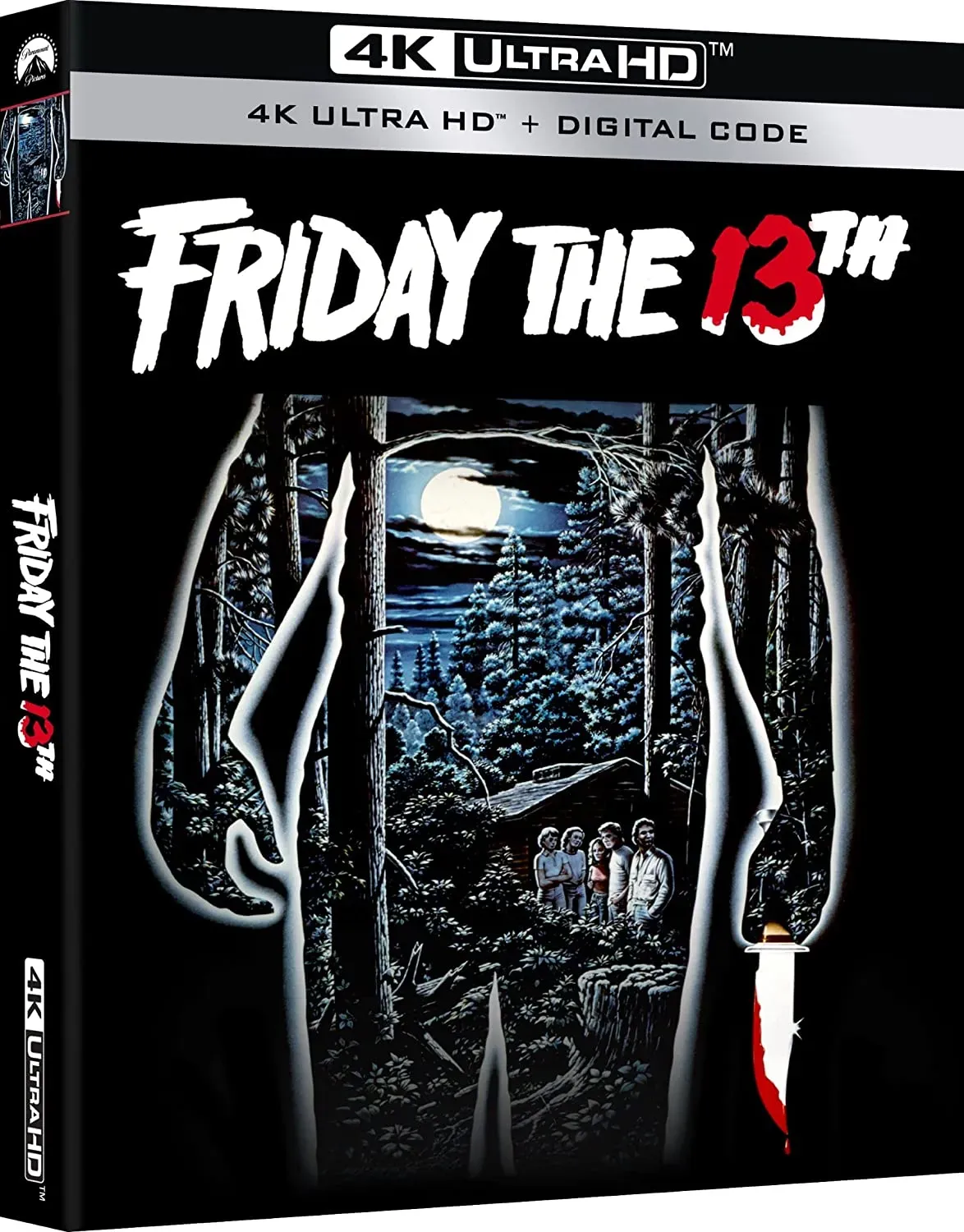
Someone much sharper than I once observed that Cunningham had started out producing soft-core pornography, and applied that genre’s tease-and-release pacing to the murders here, which explains why Friday the 13th plays so differently from Clark and Carpenter’s films: Those movies are thrillers built on mounting tension, while Cunningham isn’t interested in the slightest about sustaining it; he’s all about the money shots of gruesome violence. To be fair, said violence is created by Tom Savini at the peak of his invention, and the new 4K master lets us see more of it than ever before, bringing new details out of the print source and rendering shadows and deep blacks with exquisite clarity. Even the earlier Blu-ray looked like it was sourced from a 16mm print; now, Friday the 13th looks brand-new. Still crap, though, and now even Harry Manfredini’s score sounds like a mash-up of Bernard Herrmann’s Psycho and John Williams’ Jaws. (The sequels let him add more elements, and by Part 3 he was even having fun with it. So, good for him?)
However clunky Friday the 13th may be as a film, its impact was undeniable – which brings us to Tobe Hooper’s The Funhouse, a bizarre 1981 telepod fusion of classic horror tropes and the sex-and-death slasher formula. The story goes that Universal Studios wanted its own Friday the 13th, Hooper pitched them a teenagers-in-trouble thing with a masked killer and then made this weird, impressionistic thing set at a skeevy carnival – but he opened it with a nude scene and a direct parody of Halloween’s opening sequence, so no one could complain he hadn’t given them what they asked for.
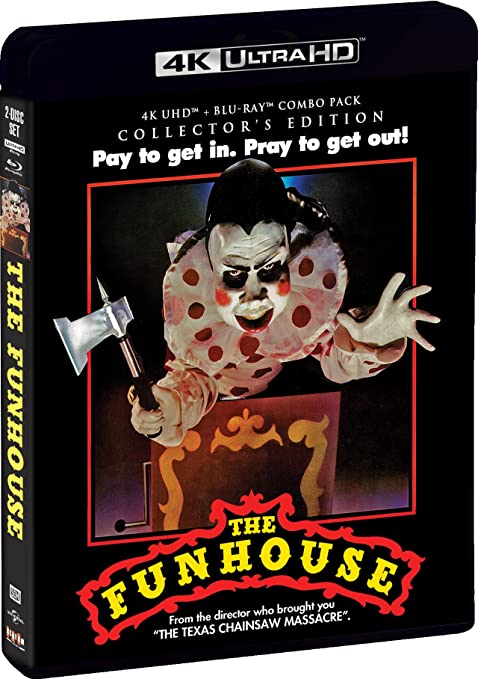
Is The Funhouse good? Honestly, having just revisited it in Shout! Factory’s new 4K edition, I’m still not sure. It captures that moment in American horror cinema when the studios started trying to horn in on scrappy indie turf, and didn’t always get the recipe right, but the bigger budgets still allowed filmmakers to take some wild swings. The plot is almost nonexistent; the whole movie takes place at an Iowa carnival where four teenagers go to a carnival, witness a murder, and spend the rest of the night trying to hide out in the remarkably cavernous funhouse, avoiding carnies bent on covering up their crime. It’s mostly an excuse for Hooper and his DP, Andrew Laszlo (who shot Walter Hill’s The Warriors around the same time), to craft violent set pieces that feel like they snuck out of Argento or Bava’s storyboards. And they look just lovely in the new 4K presentation, which offers brighter and more vivid colors than any previous transfer of the film. The greens and reds of the carnival are an almost primary palette, and skin tones read as either healthy or extremely unhealthy, as needed. (All the extras from the 2012 Shout! special edition are ported over, too, including a delightful commentary track featuring Hooper in conversation with filmmaker Tim Sullivan.)
Rick Baker’s makeup design for the killer is impressive in closeup as a fully articulated prosthetic design, if less so in longer shots when Laszlo can’t quite hide the fact that it’s just a mask on a stuntman. And the sexual aspect of the film is surprisingly frank – heavy petting here, a premature ejaculation there – in a way that grinds up against the sex-equals-death calculus of most slasher films.
It’s also a bit weird to watch actual teen Elizabeth Berridge occupy the same space with “fellow kids” Cooper Huckabee, Largo Woodruff and Miles Chapin, none of whom looks a day under 25. Wes Craven would do better with age-appropriate casting – or at least finding people who appear to be the right age – in A Nightmare on Elm Street a few years later. But The Funhouse demonstrated Hooper could do more than just hayseed horror, and that brought him to Steven Spielberg’s attention … and Poltergeist.
I’ve always had a soft spot for Poltergeist, which opened a week before Spielberg’s E.T. and has always existed in its shadow, the darker reflection of Spielberg’s other suburban fantasy. Although in hindsight it’s actually more of a mirror image of Close Encounters of the Third Kind, starting out playfully and growing more intense and threatening as the story’s stakes become clear. I’ve always assumed Spielberg shifted the malevolence of his Night Skies scripts over to Poltergeist once that project started to morph into the more family-friendly E.T.; someday, with any luck, I’ll get to ask him about it.
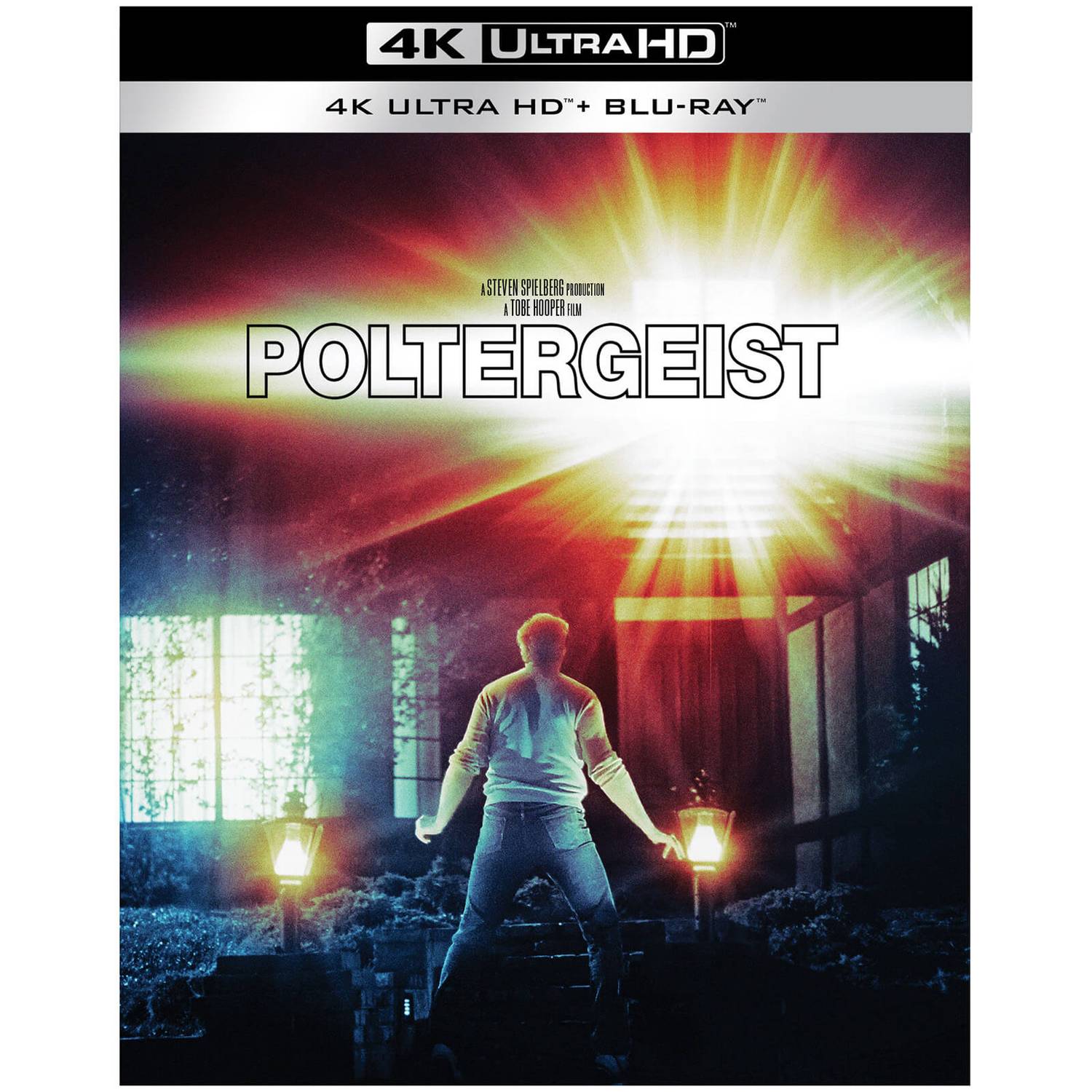
For those of you who haven’t seen Poltergeist in a while – or ever – you should know it holds up really well. Like a number of these crossover horror projects, it doesn’t follow a predetermined template as much as create it; the Insidious series wouldn’t exist without the road map Spielberg and Hooper lay down here. Although they themselves owe a considerable debt to Stephen King’s trick of thrusting realistic, fully developed characters into paranormal situations, I suppose.
The Freelings are an entirely ordinary family, their internal dynamics immediately recognizable and even charming, and JoBeth Williams and Craig T. Nelson are perfectly cast as an overmatched couple whose love for one another and their kids never wavers, and indeed drives every decision they make. The film nicely strangles the “Well, why don’t they just leave?” thing by having whatever presence is tormenting the Freelings snatch one of their kids early on; of course they won’t abandon her, no matter what else the house throws at them.
And as the movie goes on, Poltergeist escalates into more of a spookhouse ride than The Funhouse could ever have dreamed of; it’s still surprising to realize both films were made by the same person. But then Hooper never really had a specific style, shifting from the grimy relentlessness of The Texas Chain Saw Massacre and Eaten Alive to the quasi-Technicolor aesthetic of The Funhouse and the actively glossy, Spielberg-inflected slickness of Poltergeist; I can understand why people think Spielberg directed Poltergeist himself – I’d be willing to bet he was very present during pre-production – but look at Hooper’s Lifeforce, which uses almost exactly the same visual storytelling strategy and sense of mounting hysteria to tell its story. (That story is bananas, of course, but that’s a conversation for another day.) Anyway, Spielberg directed E.T. and Hooper directed Poltergeist and they both made great movies and that’s all I have to say about that. Except that Warner’s new 4K release of Poltergeist is a glorious thing.
That ’80s gloss I mentioned? You can almost touch it in this new Ultra High Definition master – happy 40thanniversary, movie! – which recaptures the hyper-realistic feel of Matthew F. Leonetti’s cinematography. The movie strives so hard to situate us in Reagan-era suburbia that you can almost smell the freshly laid grass on the Cuesta Verde lawns, and you can definitely read the labels on the products in the Freelings’ kitchen. The invasion of this mundane setting by the supernatural feels even more real as a result, its intensity escalating until these nice people – who were just sneaking a joint in their bedroom like an hour ago! – are staring down the maws of ectoplasmic manifestations and interdimensional gateways to rescue their vanished child. And even when it’s over, it isn’t over, thanks to human laziness and corporate cost-cutting – another little flourish that connects Poltergeistto slyly cynical Spielberg pictures like Jaws and Raiders.
The movie sounds great, too, its Dolby Stereo soundtrack remixed subtly and smartly in DTS-HD MA 5.1; the original matrixed surround mix is also here, in DTS-HD MA 2.0. Both tracks are present on the companion Blu-ray, which is also mastered from the new transfer; the BD is also where you’ll find a 1982 EPK featurette, the original theatrical trailer and an entirely too credulous documentary about “real” psychic investigators that was originally included on the original Blu-ray release. I’d argue it should have stayed there.
Watching Friday the 13th, The Funhouse and Poltergeist in rapid succession is a weird little time capsule, because it lets you watch the genre take shape around a certain cultural moment, its anxieties absorbed into the mainstream. By the time The Lost Boys arrived in 1987, its horror elements had become self-reflexive, even jokey, processed through the same teens-and-genre filter that defined most ’80s genre efforts. Back to the Future, Fright Night, Teen Wolf, Real Genius, My Science Project, Weird Science … trust me, I was there. It’s a long list.
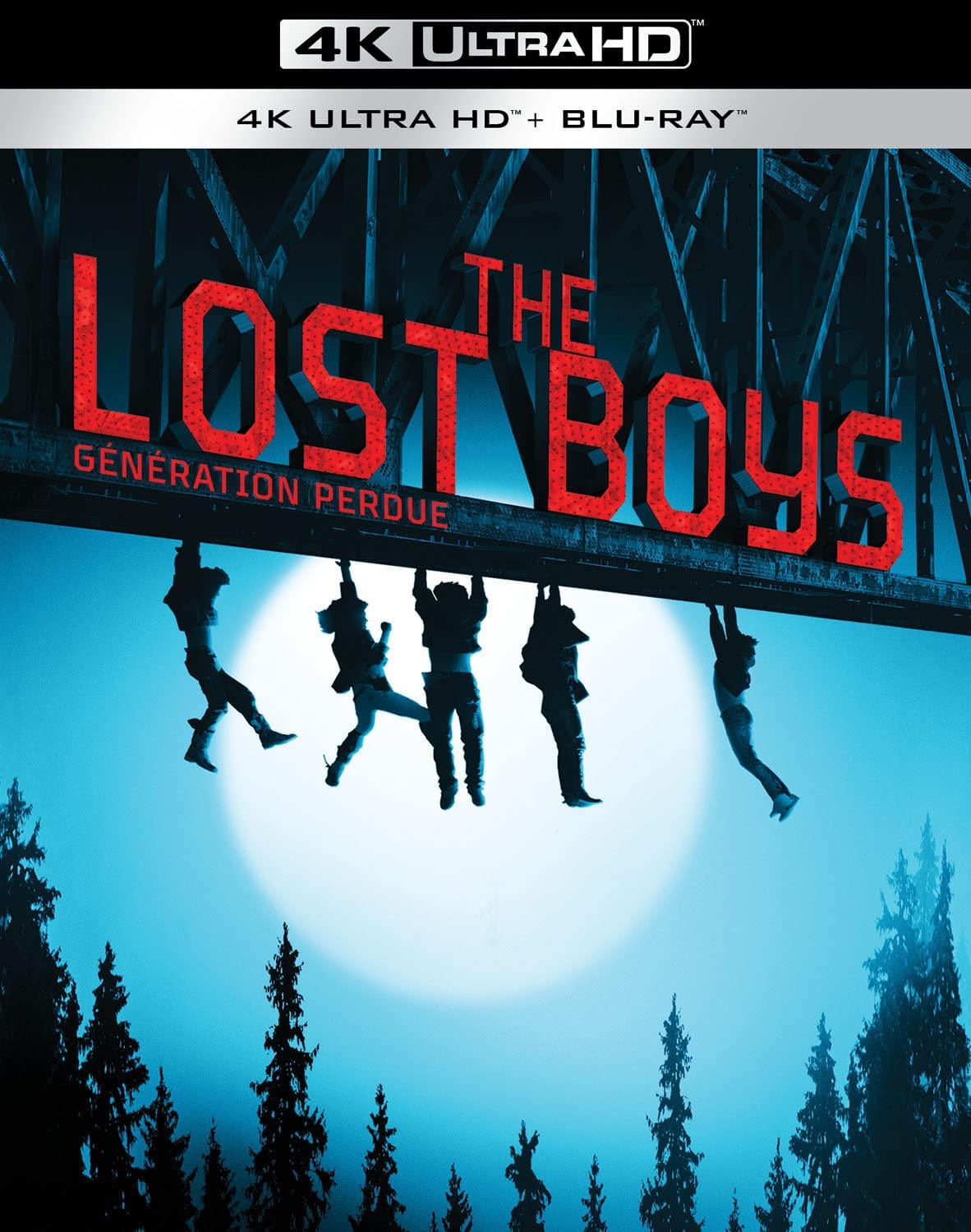
But what Joel Schumacher brought to The Lost Boys was a remarkable flexibility of tone, allowing for a film that could accommodate the creepy seduction of dashing teen Michael (Jason Patric) to the dark side of Santa Carla (“They’re only noodles, Michael”), the domestic silliness of Michael’s newly single mother (Dianne Wiest) being courted by the easily flustered Max (Ed Herrmann) and the full-bore Gooniesfranticness of Michael’s kid brother Sam (Corey Haim) being recruited into vampire-hunting by the fearless Frog brothers (Corey Feldman and Jamison Newlander).
It’s a lot, right? Then add Barnard Hughes as a cranky grandpa, Jami Gertz as winsome half-vampire Star, Kiefer Sutherland in full Goth-punk mode as vampire recruiter David and that overheated opening sequence with the sexy sax guy, and you should have a movie that goes off the rails immediately and never finds its way back … but The Lost Boys manages to turn its excess of ideas into a feature rather than a bug, sending Patric pinballing through the various storylines like the disoriented victim he is. And it arrived at the exact moment when no one would question any of it – it was the ’80s, man! What did you expect? – to become a blockbuster and a beloved touchstone of the genre. And yet the equally wild and unquantifiable InnerSpace bombed. There’s just no justice.
Warner’s 35thanniversary 4K release of The Lost Boys plays up the Schumacher garishness in a way that feels entirely appropriate to the film; the red backlighting during the vamp gang’s attack on the beach punks almost glows with intensity, while the murk of their underground clubhouse now has more subtle earth tones, looking more naturalistic and less like a soundstage than it did in the earlier Blu-ray. Like Poltergeist, this is a transfer dedicated to make the movie look like it’s fresh from the printer – and the accompanying Blu-ray, where you’ll find all the supplements from the previous BD release, has also been sourced from this new master. So that’s nice. It’s all nice, really.
Next week: Criterion rolls out another edition of Martin Scorsese’s World Cinema Collection, and since I’m on a horror kick I might take a look at Smile. Also, we find out whether a decades-old pull-quote made it onto Sony’s new 4K edition of I Know What You Did Last Summer. Make sure your subscription is up to date so you don’t miss anything, kiddies …
